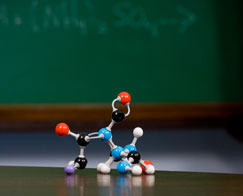Grazing Incidence Angle: Illustrating the Law of Reflection with a Twist
This lesson plan can also be downloaded: Word, PDF.
Time
30-50 min plus minimal prep time to gather the necessary materials together.
Objectives
- Verify the law of reflection.
- Consider that absorption may occur instead of reflection, and that this possibility depends upon the characteristics of the photon and the reflecting surface.
National Science Education Standards
Standard A: Science as Inquiry
- Abilities necessary to do scientific inquiry
- Understandings about scientific inquiry
Standard B: Interactions of Energy and Matter
- Waves, including sound and seismic waves, waves on water, and light waves, have energy and can transfer energy when they interact with matter.
Overview
This is recommended as a student discovery activity. This begins as a typical physics or physical science discovery activity to model and highlight the law of reflection for optics. Though it works with smoothly rolling balls, we can change the properties of the balls to create a powerful teachable moment by replacing the ball with a rolling object that produces an inelastic collision.
Materials
For each group:
- a hard, smooth ball
- String, protractor and chalk (optional)
- Graph paper and/or graphing utility
- Modeling clay – about 0.5 kg
- Sand (some other sand-like substances will work) - approximately 1-2 liters
- A piece of wood or other rigid material appropriate for a 0.25 m long ramp
Sequence of Events
- Provide each pair of students with a ball (most any type will work) and a protractor. Ask students to roll the ball at a fixed point on the wall. Ask students to vary the angle made between the path of the rolled ball and a perpendicular to the wall at the point of contact. Also carefully measured should be the angle at which the ball bounces off the wall. (see diagram) String, chalk and/or a laser pointer is sometimes useful in aiding these measurements. Begin with an angle of 0° and repeat three times. Repeat this process for angles from 0°to 80° in 10° increments.
- Students should approximate the error in their measurements and accordingly draw conclusions based upon their data. They may perform numerical analysis such as graphing θout after impact vs θin before impact, or an error analysis of their results, especially after you have given them the “accepted” result of θin = θout. Thus, relative and absolute errors are easily calculated. Additionally, the precision of the protractor should be taken into account.
Sample Data Table
Angle of incidence
(°) |
Angle of reflection
(°) |
Expected angle of reflection or is it absorbed
(°) |
Absolute error (Difference between actual and expected)
(°) |
Relative error
(%) |
| 0.0 |
|
|
|
|
| 10.0 |
|
|
|
|
| 20.0 |
|
|
|
|
| 30.0 |
|
|
|
|
| 40.0 |
|
|
|
|
| 50.0 |
|
|
|
|
| 60.0 |
|
|
|
|
| 70.0 |
|
|
|
|
| 80.0 |
|
|
|
|
Note: Now that we have modeled the law of reflection for visible light, it is time to extend the model to included different photons and different surfaces that may actually result in absorption of photons instead of reflection of them.
- Repeat the previous steps 1 and 2 but using the following progression of materials:
Changing the “reflector”:
- Put a thin layer of modeling clay (2 cm thick) on the wall and parallel to the wall to cover the area where the reflection occurred before.
- Replace the clay with sand that piles up toward the wall but is as close to parallel to the wall and flat as possible.
- Replace the sand with a ramp where there is a distance between the top edge of the ramp and the wall at least 2 times the diameter of the ball.
Changing the photon:
- Use modeling clay that is as close as possible to the size and shape of the ball used previously with any of the reflectors or the entire series of reflectors above.
Note that absorption will occur at some angles. In each case students should note the angle at which reflection begins to occur/absorption stops occurring.
- After data is collected and compiled, focus on the major point of this activity: Reflection occurs predictably according to θin = θout. Depending upon the type of radiation and reflector, it is possible that instead of reflection, absorption may occur. The greater θin, the greater the chance for reflection.
- Students should develop whatever product is normally assigned as a lab write up.
Extensions:
- How does the speed (a model for the amount of kinetic energy) affect the angle at which absorption or reflection occurs? Kinetic energy can easily be calculated for different objects and the experiment above repeated, but varying the objects instead of the surfaces. This could be done by one group in the class, half the class, or developed into a science fair project.
- This experiment naturally leads into the topic of refraction. Ask students to modify the experiment and setup to model refraction and demonstrate index of refraction. Adding a degree of difficulty, extend this idea to include total internal reflection.

Teacher's Corner